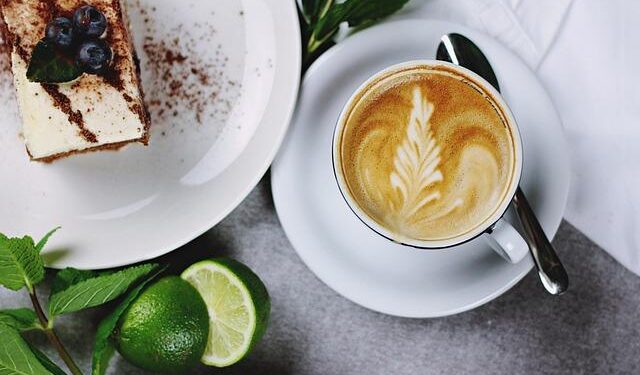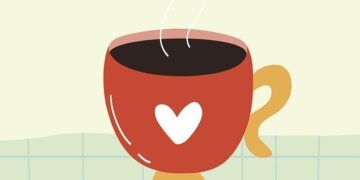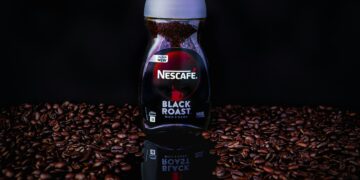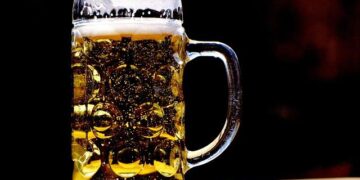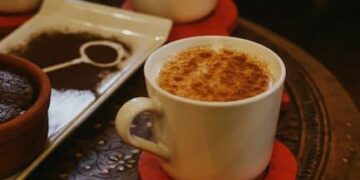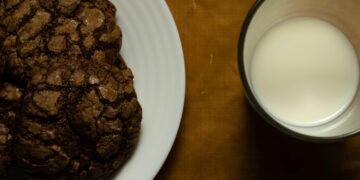Table of Contents
Part I: The Morning Disappointment
The journey began, as many do, in a state of quiet desperation.
For the narrator, a devoted admirer of the rich, complex coffee served in bustling city cafes, mornings at home were a study in contrast.
The daily ritual was not one of joyful anticipation but of grim necessity.
It started with the groan of a years-old, bargain-bin automatic drip machine, a plastic contraption like the ubiquitous Mr. Coffee that had long since earned its place on the counter through sheer persistence.1
The coffee itself came from a canister of pre-ground beans, purchased weeks, perhaps months, ago from a supermarket shelf.
Its once-promising aroma had faded into a generic, dusty scent, a pale ghost of its former self.3
The process was one of pure guesswork.
A random scoop, not a precise measuring tool, was used to portion the grounds into a flimsy paper filter—sometimes a heaping scoop, sometimes a level one, leading to a wildly inconsistent brew from one day to the next.5
Water was added directly from the kitchen tap, its mineral content an unknown and unconsidered variable.5
With the flick of a switch, the machine would sputter to life, gurgling and hissing as it produced a pot of dark, murky liquid.
The result was invariably disappointing.
The coffee was either acrid and punishingly bitter or thin, watery, and vaguely sour.
It lacked the body, the sweetness, and the nuanced flavors that made the cafe experience so enchanting.
It was a functional beverage, delivering caffeine but little else.
The machine itself, rarely subjected to more than a quick rinse, likely harbored the ghosts of brews past, with old, rancid coffee oils tainting every new P.T.6
This daily failure highlighted a fundamental disconnect.
The narrator understood that great coffee was possible, yet the path to achieving it at home seemed shrouded in mystery.
The core of the struggle was not merely a lack of technical knowledge but a difference in mindset.
In the hands of a barista, coffee brewing is a form of cooking, a craft where ingredients and variables are carefully controlled to create a specific, delicious outcome.8
At home, for the narrator and millions like them, it was a chore—a button to be pushed in a pre-caffeinated haze.
The journey from a bitter morning cup to a moment of pure sensory pleasure would be a journey of transforming that chore into a craft, demystifying the science and embracing the art of brewing.
Part II: The First Revelation – It’s Not Just the Beans, It’s the Brewer
Convinced that the primary culprit was the aging plastic machine on the counter, the narrator embarked on the first leg of the quest: finding a better brewer.
This initial step represented a crucial shift, an acknowledgment that the equipment itself plays a vital role in the quality of the final cup.
The world of automatic drip coffee makers, it turned out, was far more complex than a simple choice between black or white plastic.
It was a landscape divided into distinct tiers, from basic convenience appliances to high-performance, professionally certified machines.1
The key discovery was the Specialty Coffee Association (SCA) and its “Golden Cup Standard”.10
This standard sets out the ideal parameters for brewing, and a brewer with SCA certification guarantees it can meet them.
The most critical of these is water temperature.
Research and expert consensus confirm that the optimal temperature for extracting flavor from coffee is between 195°F and 205°F (90°C to 96°C).1
Brewing with water that is too cool results in under-extraction, leaving the coffee tasting sour and weak.
Water that is too hot can scald the grounds, leading to over-extraction and a harsh, bitter taste.5
The narrator realized their cheap machine, like most low-cost models, likely never reached this crucial temperature window, dooming every brew from the start.5
This new knowledge illuminated the market.
Brewers like the Bonavita Connoisseur (around $190) and the OXO Brew 8-Cup ($200) are praised precisely because they consistently heat water to the correct temperature and maintain it throughout the brew cycle.1
Furthermore, they feature design elements aimed at improving extraction, such as a pre-infusion or “bloom” cycle to release trapped gases from the coffee and wide showerheads that distribute water evenly over the grounds, preventing dry spots and ensuring all the coffee is extracted uniformly.1
At the higher end, the iconic Technivorm Moccamaster (starting around $285) stands as a testament to build quality and consistency, with its copper heating element and elegant, lab-like design, capable of keeping coffee hot for hours in its thermal carafe without the “stewing” effect of a hot plate.1
The narrator made a choice, investing in a quality, SCA-certified brewer like the Bonavita.
The improvement was immediate and profound.
The coffee was more balanced, the bitterness was tamed, and hints of actual flavor began to emerge.
It was the first real taste of success, a clear confirmation that the hardware matters.
Yet, the coffee still fell short of the cafe ideal.
This victory, while significant, only revealed the next layer of the puzzle, propelling the narrator deeper into their quest for the perfect cup.
The jump from a sub-$100 appliance to a $200 brewer that controls temperature correctly is perhaps the single most impactful upgrade a home brewer can make.
It establishes a foundation of proper extraction upon which all other refinements—better beans, a better grind—can be built.
Part III: The Grind Awakening – Unlocking the Science in the Cup
With a capable new brewer on the counter, the focus shifted from the machine to the ingredient at its heart: the coffee itself.
The narrator’s pre-ground, canister-stored coffee was the next obvious weak link.
This led to the most profound epiphany of the entire journey—a deep dive into the science of extraction and the paramount importance of the coffee grind.
The Science of Extraction
At its core, brewing is the process of using water to dissolve soluble flavor compounds from roasted coffee beans.16
The narrator learned to think of this process like making tea or, more dynamically, like a timeline of flavor.
When hot water hits the coffee grounds, different compounds dissolve at different rates.
The first to be extracted are acids, which contribute bright, fruity, and sometimes sour notes.
Next come the sugars and oils, which provide sweetness, body, and complexity.
Finally, the heavier, less-soluble compounds emerge, which are responsible for bitterness and astringency.18
The goal of any good brew is to stop the process in the “sweet spot,” achieving a balance where the sweetness is maximized, the acidity is pleasant, and the bitterness is minimal.
This concept unlocked the most powerful diagnostic tool any coffee drinker has: their own palate.
The narrator learned a simple but transformative rule:
- If the coffee tastes sour, sharp, or “hollow,” it is under-extracted. The brewing process stopped too early, leaving behind the desirable sweet compounds. The solution is to extract more.10
- If the coffee tastes bitter, harsh, or astringent (a dry, chalky sensation), it is over-extracted. The brewing process went on for too long, pulling out the unpleasant bitter compounds. The solution is to extract less.16
The Primacy of the Grind
This new understanding begged the question: how does one control extraction? The answer, the narrator discovered, lies almost entirely in the grind size.
The size of the coffee particles is the primary lever for controlling the rate of extraction because it determines the total surface area exposed to water.16
Imagine trying to dissolve a large rock of sugar versus a spoonful of fine granulated sugar.
The fine sugar, with its vastly greater surface area, will dissolve almost instantly.
Coffee works the same Way.
- A finer grind means more surface area, leading to a faster extraction.
- A coarser grind means less surface area, leading to a slower extraction.
This principle explains why different brewing methods demand radically different grinds.
Espresso, with its lightning-fast 25-30 second brew time, requires a very fine grind to extract flavor quickly under high pressure.
In contrast, cold brew, which steeps for 12-24 hours, uses an extra-coarse grind to slow the extraction way down and prevent bitterness.12
This revelation led to another critical insight: the difference between a blade grinder and a burr grinder.
A blade grinder, common in many kitchens, uses a spinning blade to smash beans into pieces, much like a propeller.
This violent process creates a chaotic mix of particle sizes—from large chunks (“boulders”) to fine powder (“fines”).
When brewed, this inconsistency leads to uneven extraction; the fines over-extract and become bitter while the boulders under-extract and remain sour, resulting in a muddled, unbalanced cup.17
A burr grinder, on the other hand, uses two abrasive surfaces (burrs) to mill the coffee beans to a uniform size.
The distance between the burrs is adjustable, allowing for precise control over the final particle size.16
This consistency is the secret to a clean, balanced, and repeatable cup of coffee.
The narrator realized that investing in a quality burr grinder—such as the industry-standard Baratza Encore (around $150) or the stylish Fellow Opus ($195)—was not a luxury, but a necessity.
Many experts argue it is an even more critical investment than the brewer itself, as a consistent grind is the prerequisite for good extraction, regardless of the method used.5
Armed with a new brewer and a new burr grinder, the narrator was finally equipped to take control of the brewing process.
The abstract world of coffee making was becoming a concrete science, governed by understandable principles and controllable variables.
Table 1: The Ultimate Grind Size Guide
To translate this new knowledge into practice, a simple guide is invaluable.
The following table demystifies grind sizes by linking them to familiar textures and their corresponding brewing methods.17
| Grind Name | Visual/Textural Analogy | Best For (Brewing Methods) |
| Extra-Coarse | Rock Salt | Cold Brew |
| Coarse | Coarse Sea Salt | French Press, Percolators |
| Medium-Coarse | Rough/Beach Sand | Chemex, Flat-Bottom Drippers (e.g., Kalita Wave) |
| Medium | Regular Sand | Automatic Drip Coffee Makers, AeroPress (longer brews) |
| Medium-Fine | Table Salt | Cone-Shaped Drippers (e.g., Hario V60), AeroPress (shorter brews), Moka Pots |
| Fine | Fine Granulated Sugar | Espresso, Moka Pots |
| Extra-Fine | Flour / Powder | Turkish Coffee |
Part IV: The Manual Immersion – Embracing the French Press
With the foundational principles of temperature and grind size now understood, the narrator felt empowered to venture beyond the automatic drip machine.
The goal was no longer just to make “good” coffee, but to explore the diverse world of flavor profiles.
Drawn to descriptions of “full-bodied,” “rich,” and “robust” coffee, the next logical step was to embrace one of the most classic and beloved manual brewers: the French Press.14
French Press Fundamentals: The Beauty of Immersion
The French press operates on the principle of full immersion brewing.
Unlike a drip machine where water passes through the coffee, in a French press, the coffee grounds are fully submerged and steeped in water for the entire brew duration.14
This direct and prolonged contact, combined with a simple metal mesh filter, allows more of the coffee’s natural oils and microscopic fine particles (insolubles) to remain in the final cup.
The result is a coffee with a characteristically heavy body, a rich texture, and a robust flavor profile.4
The narrator’s first attempt followed the standard, time-honored recipe: a coarse grind similar to sea salt, a coffee-to-water ratio of around 1:15 (e.g., 60 grams of coffee to 900 grams of water), and a steep time of exactly 4 minutes before slowly plunging the filter to the bottom.24
The coffee was undeniably rich and powerful, a stark contrast to the cleaner profile of the drip machine.
However, it also came with a significant drawback: the bottom of the mug was a muddy swamp of fine sediment, and the last sip was gritty and unpleasantly bitter.3
This “silt” problem is the Achilles’ heel of the traditional French press method and became the next challenge to overcome.
The Advanced Technique: The James Hoffmann Method
The solution came from the world of specialty coffee, in the form of a now-famous technique popularized by coffee expert James Hoffmann.
This method is designed specifically to mitigate the muddiness of a French press, producing a cup that retains the classic richness but boasts a surprisingly clean finish.
It requires more patience, but the results are transformative.
The narrator followed the steps, learning the logic behind each one:
- Combine Coffee and Water, Wait 4-5 Minutes: The initial steep is similar to the traditional method. A medium-coarse grind is used with a ratio around 1:16. The hot water is poured over the grounds, and a timer is set for 4 to 5 minutes. During this time, a thick “crust” of grounds forms on the surface.26
- Gently Break the Crust: After the initial steep, the crust is gently stirred. This breaks the surface tension and encourages the majority of the grounds to sink to the bottom of the carafe, ensuring they are all fully saturated and contributing to the brew.26
- Scoop the Foam and Floating Bits: Using two spoons, the remaining foam and any floating coffee particles are scooped off the surface. This is a crucial step, as these floating bits are primarily the undesirable “fines” that create sludge and bitterness in the final cup.26
- Wait an Additional 5-8 Minutes: This is the most radical departure from the traditional method and the key to its success. This extended, undisturbed wait allows the remaining fine sediment to slowly settle to the bottom of the press, forming a stable bed of grounds.26 The coffee is also cooling to a more palatable drinking temperature during this time.
- Plunge Gently, and Only to the Surface: Instead of pressing the plunger all the way down to the bottom—an action that would churn up the settled bed of sediment—the plunger is lowered slowly and gently until the mesh filter just sits below the surface of the liquid. The plunger is now acting as a strainer, not a press. It holds the majority of the grounds back while the clean coffee is poured from above.28
The result was an epiphany.
The coffee poured into the mug was remarkably clean, free of the grit and sludge that had plagued the previous attempts.
It had all the wonderful body and richness expected from a French press, but with a smooth, refined texture.
This experience revealed a deeper truth about brewing: established methods are not immutable laws.
They are starting points, solutions to the basic problem of extraction.
Advanced techniques, like Hoffmann’s, represent an evolution in thinking, targeting more nuanced problems like textural refinement.
They demonstrate that even the simplest brewers possess hidden depths, and by understanding the why behind each step, a home brewer can modify and “hack” their tools to overcome their inherent limitations and achieve a truly exceptional result.
Part V: The Ritual of Control – Mastering the Pour-Over
The journey into the French press unlocked an appreciation for body and richness.
However, the narrator soon encountered a new kind of coffee that demanded a different approach.
A bag of freshly roasted single-origin beans from Ethiopia promised “bright, sparkly, floral” and “fruity lemonade” notes.14
Brewing these delicate beans in the French press, the narrator found that the heavy body and oils, while lovely with a chocolatey Sumatran coffee, seemed to mute and overpower these lighter, more ethereal flavors.14
The quest for flavor clarity led directly to the method favored by baristas and coffee connoisseurs for showcasing the unique character of a coffee: the pour-over.
Pour-Over Fundamentals: The Art of Percolation
Pour-over brewing is a method of percolation.
Unlike the full immersion of a French press, here the water continuously passes through a bed of coffee grounds and a paper filter.23
This process, combined with the paper filter’s ability to trap nearly all oils and fine particles, results in a cup with exceptional
clarity.
The flavors are distinct and well-defined, the body is lighter (often described as “tea-like”), and the subtle nuances of a coffee’s origin—its acidity, fruitiness, and floral aromas—are brought to the forefront.14
Embracing pour-over meant embracing it as a ritual.
It is a manual, hands-on process that requires more attention and equipment than a French Press. The narrator acquired the essential toolkit: a dripper, paper filters, a digital scale for precise measurements of coffee and water, and, most importantly, a gooseneck kettle.
The long, curved spout of a gooseneck kettle is not merely for aesthetics; it provides crucial control over the flow rate and direction of the water, which is essential for achieving an even and consistent extraction.11
Dripper Showdown: V60 vs. Kalita Wave
The narrator quickly learned that not all drippers are created equal.
The shape of the dripper profoundly affects how water flows through the coffee, which in turn changes the brewing dynamics.
Two dominant styles emerged:
- Hario V60 (Conical Dripper): Characterized by its 60-degree cone shape, large single exit hole, and spiral ribs along the interior walls. These features promote a fast flow rate, meaning the brew time and extraction are highly dependent on the user’s pouring technique. A slow pour will result in a longer brew; a fast pour will be shorter. This makes the V60 less forgiving but offers the user maximum control to manipulate the brew. It is the choice for those who want to fine-tune every variable.21
- Kalita Wave (Flat-Bottom Dripper): This dripper has a flat bottom with three small holes. This design restricts the flow of water, causing it to “pool” slightly above the coffee bed before draining. This built-in resistance creates a more even, gentle, and consistent extraction, making the Kalita Wave much more forgiving for beginners. It is less sensitive to minor variations in pouring technique.21
The Pour-Over Process and the Great Epiphany
Mastering the pour-over involved learning a sequence of steps, each with a specific purpose.
A typical recipe for a single cup might involve 20 grams of coffee and 330 grams of water, aiming for a total brew time of 3 to 3:30 minutes.34
- The Bloom (0:00 – 0:45): The process begins by pouring a small amount of hot water (typically 2-3 times the weight of the coffee grounds) evenly over the coffee bed. The grounds swell and bubble as they release trapped carbon dioxide (CO2). This “bloom” is critical; it prevents the gas from creating dry pockets or “channels” in the coffee bed later, ensuring all the grounds are saturated and extracting evenly from the very beginning.33
- The Main Pours (Agitation and Percolation): After the bloom, the remaining water is added in one or more stages. The narrator experimented with a single, slow, continuous pour versus multiple “pulse” pours. Each pour creates agitation, the turbulence of water mixing with and stirring the coffee grounds, which increases the rate of extraction.30 Many advanced recipes call for more aggressive agitation early in the brew to extract sugars, followed by gentler pours at the end to avoid over-extracting bitter compounds.33
- Dialing In: The final piece of the puzzle was learning to “dial in” the brew. The total brew time serves as a crucial diagnostic indicator. If a 3:30 minute recipe finishes in just 2:30, the coffee will likely be sour and under-extracted. If it takes 5 minutes, it will probably be bitter and over-extracted.11
This led to the narrator’s next great epiphany, a concept that often confuses beginners.
In immersion brewing like the French press, grind size and brew time are largely independent variables.
One can choose a coarse grind and steep it for 4 minutes or 10 minutes.
In percolation brewing, however, grind size directly determines the brew time.
A finer grind creates a more compact, denser coffee bed.
This increases the resistance to water flow, forcing the water to pass through more slowly and thus lengthening the brew time and increasing extraction.10
Conversely, a coarser grind creates a looser bed with larger gaps, allowing water to flow through more quickly,
shortening the brew time and decreasing extraction.
This creates a seemingly counter-intuitive relationship.
To fix a sour (under-extracted) pour-over, one needs more extraction.
This is achieved by grinding finer.
This finer grind, in turn, makes the brew take longer.
The causal chain is: Finer Grind → Slower Water Flow → Longer Contact Time → More Extraction.
This understanding was a breakthrough.
It clarified why one cannot simply decide to “brew for 3 minutes” with a pour-over; the brew time is an output, a result of the grind size and pouring technique, not an independent input you can set on a timer.10
With this knowledge, the narrator could finally craft a cup that was clean, sweet, and bursting with the delicate floral notes of the Ethiopian beans.
Part VI: The Traveler’s Companion & The Stovetop Classic
The narrator’s coffee journey, now rich with experience in both immersion and percolation, expanded to meet the demands of a modern lifestyle.
Two new challenges arose: the need for great coffee while traveling and the desire for a quick, intense, espresso-like jolt in the afternoon without the expense and counter space of a full espresso machine.
This led to the exploration of two iconic and highly specialized brewers: the AeroPress and the Moka P.T.
The AeroPress: The Ultimate Chameleon
For the traveler, the AeroPress emerged as the perfect solution.
Made of durable, lightweight plastic, it’s virtually indestructible and packs down into a compact cylinder, making it an ideal companion for coffee on the go.14
But its true genius lies in its unparalleled versatility.
The narrator discovered that the AeroPress is not just one brewer; it’s a brewing system that can function as both a percolation and an immersion device, offering incredible control in a simple package.
This versatility hinges on two distinct techniques:
- The Standard Method: In this orientation, the AeroPress is placed directly on a mug, filter-side down. Coffee and water are added to the chamber. As soon as water is poured, some liquid begins to drip through the filter, creating a brief, uncontrolled percolation phase before the plunger is inserted and pressed.37 This method is fast, straightforward, and tends to produce a bolder, heavier-bodied cup of coffee.39
- The Inverted Method: This popular technique, developed by AeroPress enthusiasts, turns the brewer into a true full-immersion device. The brewer is assembled upside-down, with the plunger inserted partway into the chamber from the start. Coffee and water are added, and because the filter cap is not yet attached, no coffee can drip out. This traps all the water with the grounds, allowing for a controlled steep time of any desired length, just like a French press.40 After steeping, the filter cap is screwed on, the entire device is carefully flipped onto a mug, and the coffee is pressed. This method gives the brewer complete control over the brew time, prevents any under-extracted drips, and often results in a cup with a richer mouthfeel and more body than the standard method.37
The AeroPress, with its ability to shift between brewing styles, its portability, and its paper micro-filter that produces a clean, grit-free cup, revealed itself to be the “Swiss Army knife” of the coffee world—a single tool for a multitude of situations.14
The Moka Pot: The Espresso Impersonator
To satisfy the craving for an intense, syrupy coffee concentrate, the narrator turned to a classic of Italian design: the Moka P.T. For a modest investment of under $50, this stovetop brewer promises a rich, “espresso-like” experience.43
It operates on a unique principle of
steam pressure.
Water in the sealed lower chamber is heated on a stove.
As it boils, the trapped steam creates pressure (around 1-2 bars, far less than an espresso machine’s 9 bars) that forces hot water up through a middle basket filled with coffee grounds and into the upper chamber as brewed coffee.45
However, the narrator’s first attempts were a disaster, yielding a brew that was metallic, burnt, and intensely bitter.
This frustrating experience is common and stems from treating the Moka pot like a miniature espresso machine.
Success came only after understanding and correcting these common mistakes:
- Using the Wrong Grind Size: An espresso-fine grind is too fine for a Moka pot. It will compact and clog the filter basket, severely restricting water flow and leading to scorching and over-extraction. The ideal grind is medium-fine, similar in texture to table salt, which allows water to pass through evenly.45
- Tamping the Coffee: This is the cardinal sin of Moka pot brewing. Unlike with espresso, the coffee grounds in the basket should be leveled off but never tamped or compacted. Tamping creates far too much resistance for the pot’s low-pressure system to overcome, which can result in a stalled brew or even a dangerous pressure buildup.47
- Using Excessive Heat: Placing the Moka pot over a high flame is a recipe for burnt, metallic-tasting coffee. The key is to use low to medium heat, which allows for a gentle, steady extraction. The brew is complete when the pot begins to gurgle and sputter; it should be removed from the heat immediately at this point.49
- Incorrect Water Level and Quality: The water chamber should be filled with fresh, filtered water only up to the fill line or just below the small, circular safety valve. Overfilling or underfilling can disrupt the pressure dynamics and lead to a poor extraction.47
By respecting the Moka pot’s unique design, the narrator was finally able to produce a wonderfully rich, intense, and satisfying cup.
This chapter of the journey taught a crucial lesson: every brewer operates within a specific “design envelope” governed by physics.
Trying to force a brewer to behave like something it’s not—like treating a low-pressure Moka pot like a high-pressure espresso machine—is a path to failure.
Success comes from understanding and working with the brewer’s inherent design, not against it.
Part VII: The Final Frontier – Taming the Espresso Machine
Having explored the realms of drip, immersion, percolation, and steam pressure, the narrator stood at the final frontier of home coffee brewing.
The quest for the ultimate cafe experience led inevitably to its source: the espresso machine.
This was the pinnacle of the journey, the most challenging, expensive, and potentially rewarding endeavor of them all.
Espresso: Coffee Under a Microscope
The narrator had learned to think of espresso as “coffee under a microscope,” a powerful analogy that perfectly captures its nature.14
The process uses a pump to force a small amount of hot water through a tightly packed puck of finely ground coffee at an immense pressure of around 9 bars (130 psi).12
This intense, high-pressure environment speeds up extraction dramatically, pulling a concentrated “shot” of coffee in just 25 to 30 seconds.
Because the resulting beverage is so concentrated, every characteristic of the coffee is amplified.
Bright, acidic notes in the beans become piercingly so in the cup; rich, sweet flavors become profoundly deep.
And, most intimidatingly, any flaw in the beans or the barista’s technique is magnified, with no place to hide.14
The Unforgiving Art of “Dialing In”
The central challenge of making espresso is a process known as “dialing in.” It is a delicate balancing act between three core variables, often called the “holy trinity” of espresso:
- Dose: The weight of the dry coffee grounds in the portafilter basket.
- Yield: The weight of the liquid espresso in the cup.
- Time: The duration of the extraction, from the moment the pump is engaged to when it is stopped.
The industry-standard starting point for a balanced shot is a 1:2 brew ratio (e.g., 18 grams of coffee grounds producing 36 grams of liquid espresso) achieved in a time window of 25 to 30 seconds.12
The narrator, after investing in an entry-level home espresso setup—a machine like the Breville Bambino and a capable grinder, a combination that starts around $500-$650—began the frustrating but enlightening trial-and-error process.53
- The Gusher: The first attempt was a disaster. The shot started pouring almost immediately, gushing out of the portafilter in a pale, watery stream. The total shot time was a mere 10 seconds. The taste was overwhelmingly sour and thin. Diagnosis: A classic case of under-extraction. The water flowed through the coffee puck too quickly to dissolve the sweet compounds. Solution: The grind was too coarse. To increase resistance and slow the water down, the narrator had to grind finer.12
- The Choked Shot: After adjusting the grinder to a much finer setting, the next attempt went to the opposite extreme. The machine strained, and after several seconds, only a few dark, tar-like drips emerged. The shot took nearly a minute to produce a tiny amount of liquid that tasted punishingly bitter and burnt. Diagnosis: Over-extraction. The grind was now too fine, creating a coffee puck so dense that the water could barely penetrate it, a phenomenon known as “choking” the machine. Solution: Grind coarser, but this time, only by a tiny increment.12
- The “God Shot”: After numerous attempts, making minuscule adjustments to the grinder setting between each one, it finally happened. The espresso began to flow not as a gusher or a drip, but as a steady, viscous stream, often described as looking like “warm honey”.12 It hit the target yield of 36 grams in exactly 28 seconds. The taste was transformative: a perfect balance of sweetness and acidity, with a rich, syrupy body and a long, pleasant aftertaste. This was the “god shot,” the successful culmination of the entire dialing-in process.
This experience revealed the unique role of variables in the world of espresso.
In all other brewing methods, time is either a direct input (like the 4-minute steep in a French press) or a general output that helps diagnose the grind (like in pour-over).
In espresso, the 25-30 second window is a target.
The primary variable used to hit that target is the grind size.
The barista doesn’t set a timer; they adjust the grind until the physics of water flowing through the coffee puck naturally results in the correct shot time.
This fundamental shift in thinking—where grind becomes the tool to control time—is the conceptual leap that separates espresso from all other methods and solidifies its reputation as the final, most demanding frontier for the home brewer.
Part VIII: The Ultimate Epiphany – There Is No “Best” Brewer
After a long and winding journey—from the despair of a bad drip machine to the triumph of a perfectly dialed-in espresso shot—the narrator stood before their kitchen counter, now transformed into a well-equipped coffee station.
There sat the reliable automatic drip brewer, the robust French press, the elegant pour-over dripper, the versatile AeroPress, and the formidable espresso machine.
Looking at this collection, the final and most important epiphany dawned: the quest was never about finding a single “best” brewer.
It was about building a versatile toolkit.
The ultimate realization was that the “perfect cup” is not a static, singular ideal.
It is a dynamic concept that changes with the coffee, the mood, and the moment.
The true goal was to gain the knowledge to select the right tool for the right job.14
- On a weekend morning with a bag of bright, floral Kenyan beans, the choice would be the pour-over (V60), its clean percolation method perfectly suited to highlighting the coffee’s delicate acidity and wine-like notes.14
- When brewing a rich, earthy Sumatran coffee with deep chocolatey notes, the French press would be the ideal instrument, its immersion process and metal filter preserving the oils that contribute to a heavy, satisfying body.23
- For a quick, clean, and consistent cup on a busy weekday morning or while traveling, the AeroPress would be the go-to, its hybrid nature offering speed without sacrificing quality.14
- When guests are over and a full pot is needed without fuss, the high-quality automatic drip machine would perform its duty flawlessly, delivering a balanced and crowd-pleasing brew.2
- And for that intense, dessert-like after-dinner drink, the Moka pot or the espresso machine would be called upon to deliver that concentrated, syrupy shot of coffee.
The true prize of the journey was not a piece of hardware, but a deep understanding of the fundamental principles of coffee extraction.
Knowledge of the interplay between grind size, coffee-to-water ratio, temperature, and time is a universal key.
This knowledge empowers a brewer to make any coffee better, with any device they have on hand.
The frustration and mystery that began the quest had been replaced by confidence and creativity.
The world of specialty coffee can seem intimidating, filled with jargon and expensive equipment.
But at its heart, it is an invitation to be curious, to experiment, and to engage your senses.
The final message from the narrator’s journey is a simple and encouraging one: start where you are, change one variable at a time, and taste the results.
There is no right or wrong answer, only what you find delicious.
In the end, the best way to brew is your Way. As the experts say, “You brew you”.14
Table 2: At-a-Glance Brewer Comparison
To help guide the beginning of your own journey, this table provides a summary of the most common home brewing methods, their characteristics, and what they are best suited for.
| Brewer | Brewing Principle | Flavor Profile | Ease of Use | Cost of Entry (2025) | Best For… |
| Automatic Drip | Percolation | Balanced, Classic, Clean | Very Easy | $65 – $350 | Convenience, brewing for multiple people, consistency 2 |
| French Press | Full Immersion | Rich, Full-Bodied, Robust | Easy | $20 – $150 | Highlighting body and texture, rich and chocolatey coffees 14 |
| Pour-Over | Percolation | Clean, Bright, Nuanced, High Clarity | Moderate | $25 – $100+ | Highlighting delicate and acidic flavors, ritual, full control 14 |
| AeroPress | Hybrid (Immersion/Pressure) | Clean, Versatile, Full-Flavored | Easy | $40 – $90 | Travel, versatility, quick single cups, experimentation 14 |
| Moka Pot | Steam Pressure | Intense, Bold, Syrupy, “Espresso-like” | Moderate | $20 – $60 | Strong, concentrated coffee without an espresso machine 43 |
| Espresso Machine | High Pressure | Concentrated, Amplified, Intense | Difficult | $500+ | True espresso and milk drinks, the ultimate coffee hobby 12 |
Works cited
- 10 Best Coffee Makers 2025 | The Strategist – New York Magazine, accessed August 2, 2025, https://nymag.com/strategist/article/best-coffee-makers.html
- Best Coffee Maker of 2025 – CNET, accessed August 2, 2025, https://www.cnet.com/home/kitchen-and-household/best-coffee-maker/
- French press. How much does the grind change the flavor? : r/Coffee – Reddit, accessed August 2, 2025, https://www.reddit.com/r/Coffee/comments/6kwhcj/french_press_how_much_does_the_grind_change_the/
- French Press Brew Guide | Craft Coffee, accessed August 2, 2025, https://www.craftcoffee.com/how-to-make-coffee/french-press-brew-guide
- The Top 3 Mistakes Everyone Makes When Brewing Coffee at Home, According to Coffee Experts – EatingWell, accessed August 2, 2025, https://www.eatingwell.com/the-mistake-everyone-makes-when-brewing-coffee-11702869
- 5 Common Mistakes Using a Brewed Coffee Maker – Bruvi, accessed August 2, 2025, https://bruvi.com/blogs/articles/5-common-mistakes-using-a-filter-coffee-maker
- Top 9 Mistakes to Avoid When Brewing Coffee, accessed August 2, 2025, https://stonestreetcoffee.com/blogs/brooklyn-coffee-academy/top-9-mistakes-to-avoid-when-brewing-coffee
- What is Braising? | Understanding Braising Cooking Method | Stahl …, accessed August 2, 2025, https://stahlkitchens.com/blogs/news/braising-cooking-method
- What is Braising? – blog.ca – Pampered Chef, accessed August 2, 2025, https://blog.pamperedchef.ca/kitchen-tips-tools/braising-means-searing-or-browning-an-ingredient-to-develop-color-and-flavor-then-simmering-it-in-a-flavorful-liquid-so-it-becomes-tender/
- How To Grind For Pour Over Coffee?, accessed August 2, 2025, https://batchcoffee.co.uk/stories/pour-over-grind/
- Guide To Pour-Over Coffee, accessed August 2, 2025, https://counterculturecoffee.com/blogs/counter-culture-coffee/guide-to-pour-over-coffee
- What Grind Size for Espresso: Unlocking the Perfect Brew – Cliff & Pebble, accessed August 2, 2025, https://cliffandpebble.com/blogs/our-blog/what-grind-size-for-espresso
- 5 SCA Golden Cup Certified Home Coffee Makers – Whole Latte Love, accessed August 2, 2025, https://www.wholelattelove.com/blogs/comparisons/5-sca-golden-cup-certified-home-brewers
- Coffee Basics: Brewing Methods, accessed August 2, 2025, https://counterculturecoffee.com/blogs/counter-culture-coffee/coffee-basics-brewing-methods
- The best coffee maker 2025: espresso and filter made easy – TechRadar, accessed August 2, 2025, https://www.techradar.com/best/best-coffee-machines
- The Complete Guide to Coffee Grind Size, accessed August 2, 2025, https://www.drinktrade.com/blogs/how-to/coffee-grind-size-chart
- Coffee Grind Size Chart: How Grind Size Affects Coffee Flavor – 2025 – MasterClass, accessed August 2, 2025, https://www.masterclass.com/articles/coffee-grind-size-chart
- What is the relationship between grind size, brewing time and coffee amount? – Reddit, accessed August 2, 2025, https://www.reddit.com/r/pourover/comments/1b23cni/what_is_the_relationship_between_grind_size/
- What’s the Relationship Between Grind and Brew Time? : r/Coffee – Reddit, accessed August 2, 2025, https://www.reddit.com/r/Coffee/comments/z72b75/whats_the_relationship_between_grind_and_brew_time/
- How to Dial In Your Coffee Grind: A Beginner’s Guide – Naomi Joe Coffee, accessed August 2, 2025, https://naomijoecoffee.com/blogs/learn/how-to-dial-in-coffee-grind
- How to Dial In the Perfect Grind Size for Pour Over Coffee – 1Zpresso, accessed August 2, 2025, https://1zpresso.coffee/how-to-dial-in-the-perfect-grind-size-for-pour-over-coffee/
- Best Budget Coffee Grinders for 2025 – CoffeeGeek, accessed August 2, 2025, https://coffeegeek.com/guides/feature-guides/best-budget-coffee-grinders-for-2025/
- What is the Best Coffee Brewing Method for Maximum Flavour?, accessed August 2, 2025, https://chimneyfirecoffee.com/blogs/news/what-is-the-best-coffee-brewing-method-for-maximum-flavour
- PT’s French Press Brew Guide, accessed August 2, 2025, https://ptscoffee.com/pages/pts-french-press-brew-guide
- Brewing Basics: French Press Steep Times – Planetary Design, accessed August 2, 2025, https://planetarydesign.com/blogs/news/how-long-to-steep-french-press-coffee
- The Step-by-Step Guide to James Hoffmann’s French Press Method, accessed August 2, 2025, https://sevencoffeeroasters.com/blogs/coffee-101/james-hoffmann-french-press
- French Press by James Hoffman – Coffee Coach, accessed August 2, 2025, https://coffee-coach.netlify.app/french-press-by-james-hoffman/
- Having doubts about the Hoffman French Press method : r/Coffee – Reddit, accessed August 2, 2025, https://www.reddit.com/r/Coffee/comments/tnizcu/having_doubts_about_the_hoffman_french_press/
- The Good and Bad of James Hoffmann’s French Press Technique… – Espresso Insiders, accessed August 2, 2025, https://espressoinsiders.com/brewing/french-press/the-good-and-bad-of-james-hoffmanns-french-press-technique/
- Advanced pour over tips thread : r/Coffee – Reddit, accessed August 2, 2025, https://www.reddit.com/r/Coffee/comments/itxg2x/advanced_pour_over_tips_thread/
- 20 Coffee Brewing Methods: Different Ways To Make Coffee at …, accessed August 2, 2025, https://colipsecoffee.com/blogs/coffee/brewing-methods
- Master the Art of Single Origin Coffee Brewing: Tips, Tricks, and Essential Equipment, accessed August 2, 2025, https://www.ritualcoffeeworks.com/journal/master-the-art-of-single-origin-coffee-brewing-tips-tricks-and-essential-equipment
- The Coffee Chronicler’s Guide to Pour Over Coffee (Geek Warning …, accessed August 2, 2025, https://coffeechronicler.com/pour-over-coffee-instructions/
- Pour Over Brew Guide – Novel Coffee Roasters, accessed August 2, 2025, https://www.novelcoffeeroasters.com/pages/drip-pour-over-brew-guide
- How To Improve Your Pour Over Technique | Advanced Brewing Skills Lab – YouTube, accessed August 2, 2025, https://www.youtube.com/watch?v=LR88sRCzekg
- What grind size should I use? | AeroPress Grind Size, accessed August 2, 2025, https://aeropress.com/pages/what-grind-size-should-i-use
- The Inverted AeroPress Method: A Guide – Perfect Daily Grind, accessed August 2, 2025, https://perfectdailygrind.com/2020/10/the-inverted-aeropress-method-a-guide/
- Thoughts on the regular Aeropress method – Steampunk Coffee Roasters, accessed August 2, 2025, https://www.steampunkcoffee.co.uk/blogs/steampunk-coffee-blog/thoughts-on-the-regular-aeropress-method
- Inverted Vs. Standard Aeropress Method – Which Makes Better Coffee?, accessed August 2, 2025, https://bigcupofcoffee.com/inverted-vs-standard-aeropress-method/
- Aeropress Brew Guide | Craft Coffee, accessed August 2, 2025, https://www.craftcoffee.com/how-to-make-coffee/aeropress-brew-guide
- Difference between inverted and normal aeropress? – Coffee Stack Exchange, accessed August 2, 2025, https://coffee.stackexchange.com/questions/2517/difference-between-inverted-and-normal-aeropress
- Guide To The AeroPress – Counter Culture Coffee, accessed August 2, 2025, https://counterculturecoffee.com/blogs/counter-culture-coffee/guide-to-the-aeropress
- A Grind Size Guide For Moka Pot Coffee, accessed August 2, 2025, https://peakflavorcoffee.com/blogs/moka-pot/moka-pot-grind-size
- The Moka Pot Review and Comparison 2025 – Coffeeness, accessed August 2, 2025, https://www.coffeeness.de/en/moka-pot/
- How Fine to Grind Coffee for Moka Pot – 4 Simple Steps (2025 …, accessed August 2, 2025, https://www.kimbocoffee.com/blogs/kimbo-blog/how-fine-to-grind-coffee-for-moka-pot
- What’s your favorite coffee brewing method and why? – Quora, accessed August 2, 2025, https://www.quora.com/What-s-your-favorite-coffee-brewing-method-and-why
- espressoinsiders.com, accessed August 2, 2025, https://espressoinsiders.com/brewing/moka-pot/17-key-moka-pot-mistakes-you-should-avoid/
- Why Your Moka Pot Coffee Tastes WRONG – Easy Fix! – YouTube, accessed August 2, 2025, https://www.youtube.com/watch?v=mrWcnGDECLk
- I finally figured out the trick to a GREAT moka pot coffee. – Reddit, accessed August 2, 2025, https://www.reddit.com/r/Coffee/comments/s4n6oq/i_finally_figured_out_the_trick_to_a_great_moka/
- 12 Common Moka Pot Problems and How to Fix Them – Hexnub, accessed August 2, 2025, https://www.hexnub.com/blogs/news/10-common-moka-pot-problems-and-how-to-fix-them
- Espresso Brewing Time: Mastering the Art of Perfection, accessed August 2, 2025, https://barista-espresso.se/blogs/espresso-guide/espresso-brewing-time-mastering-the-art-of-perfection
- A Guide To Dialling In Espresso – Perfect Daily Grind, accessed August 2, 2025, https://perfectdailygrind.com/2020/07/a-guide-to-dialling-in-espresso/
- Home Espresso Coffee Machines – Automatic & Manual – Breville, accessed August 2, 2025, https://www.breville.com/en-us/shop/espresso
- Best Beginner Machine in 2024/2025 for a casual person [max $1500] : r/espresso – Reddit, accessed August 2, 2025, https://www.reddit.com/r/espresso/comments/1jixhm4/best_beginner_machine_in_20242025_for_a_casual/
- How to Adjust Grind Setting on an Espresso Machine: Achieving Your Perfect Shot, accessed August 2, 2025, https://www.787coffee.com/787-coffee-how-tos-a-guide-to-making-better-coffee-at-home/how-to-adjust-grind-setting-on-an-espresso-machine-achieving-your-perfect-shot
- The Best Brew Methods for Every Origin – Fresh Roasted Coffee, accessed August 2, 2025, https://www.freshroastedcoffee.com/blogs/brew-guides/the-best-brew-methods-for-every-origin
- The Best French Press Coffee Makers, Tested and Reviewed – The Spruce Eats, accessed August 2, 2025, https://www.thespruceeats.com/best-french-press-coffee-makers-4154244
- The 7 Best Pour-Over Coffee Makers of 2025, Tested & Reviewed – Serious Eats, accessed August 2, 2025, https://www.seriouseats.com/best-pourover-coffee-makers-5441631
- AeroPress Coffee Makers | The French Press Alternative, accessed August 2, 2025, https://aeropress.com/
